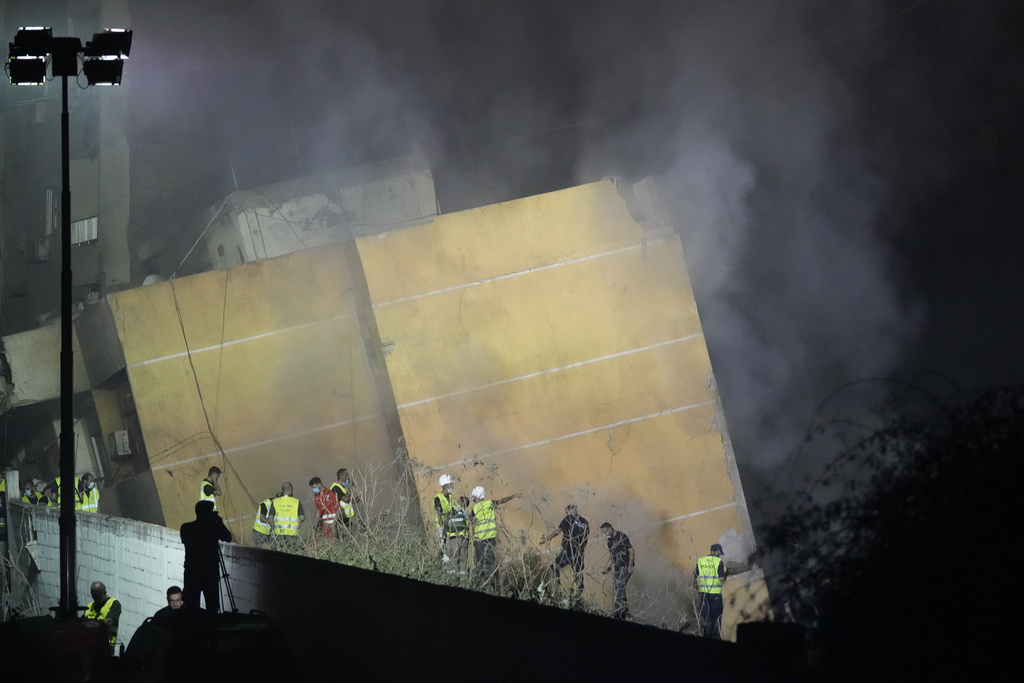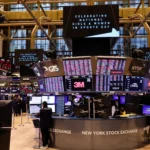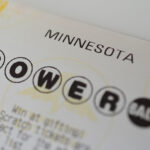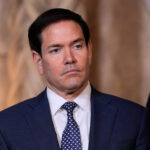Hezbollah Leader Targeted in Israeli Airstrikes, Six Dead \ Newslooks \ Washington DC \ Mary Sidiqi \ Evening Edition \ The Israeli military struck Hezbollah’s headquarters in Beirut, targeting the group’s leader, Hassan Nasrallah, and leveling multiple buildings. The attack left at least six people dead and 91 wounded, heightening fears of a full-scale conflict. Prime Minister Benjamin Netanyahu, returning from the U.S., vowed that Israel’s campaign against Hezbollah would continue.
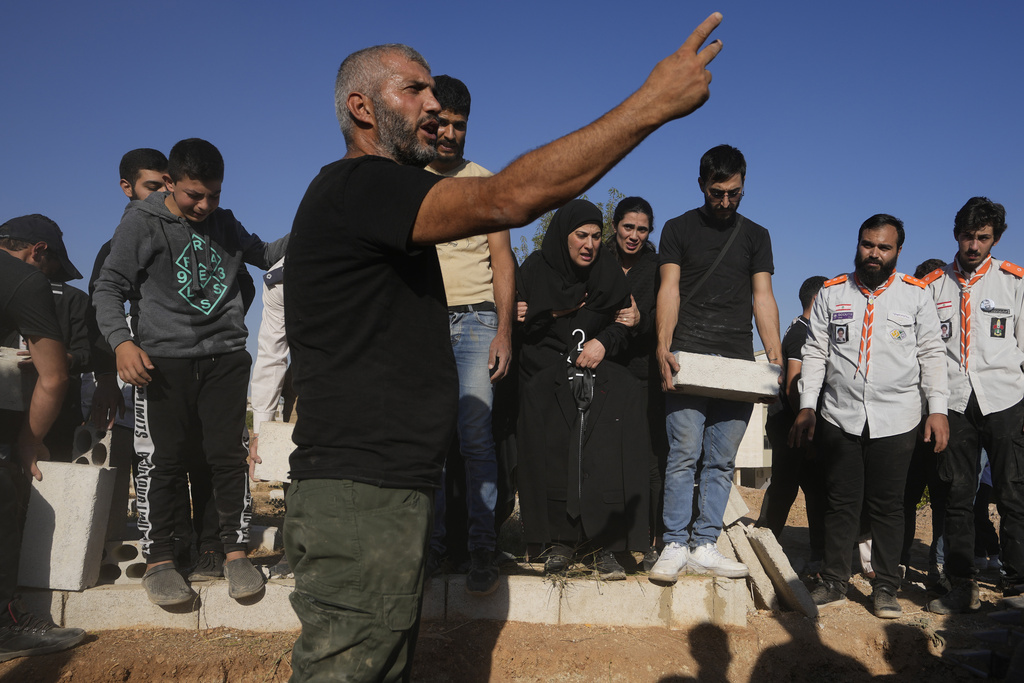
Israeli Airstrikes in Beirut: Quick Looks
- Israel struck Hezbollah’s headquarters in Beirut, targeting leader Hassan Nasrallah.
- Multiple apartment buildings were destroyed; six killed, 91 wounded.
- Prime Minister Netanyahu returned from the U.S., vowing continued attacks.
- Escalating strikes come as Israel responds to 11 months of Hezbollah rocket fire.
- No public confirmation of Nasrallah’s presence at the targeted site.
- Hezbollah retaliated by launching rockets at Safed, injuring one civilian.
- Hezbollah has not confirmed any casualties from the strikes.
- President Biden briefed on the strike; U.S. assessing military posture in the region.
Deep Look
The escalating conflict between Israel and Hezbollah reached a new level on Friday, as Israeli airstrikes targeted Hezbollah’s headquarters in Beirut, resulting in massive explosions that leveled several high-rise buildings and marked one of the biggest attacks on the Lebanese capital in the past year. Israeli military sources confirmed that the strikes aimed at eliminating Hezbollah’s leadership, specifically targeting its head, Hassan Nasrallah. The assault killed at least six people and injured 91, according to Lebanon’s Health Ministry, with the number of casualties expected to rise as rescue operations continue.
The attack took place at nightfall in the Haret Hreik neighborhood, a densely populated, predominantly Shiite district of Beirut’s Dahiyeh suburbs, often known as the heart of Hezbollah’s operations. The strikes were described as “massive,” reducing at least six residential towers to rubble. As buildings collapsed, a wall of thick black and orange smoke rose over the city, shaking windows and houses as far as 18 miles away from the strike site. The Lebanese national news agency reported widespread damage and scenes of chaos, as residents fled carrying whatever belongings they could grab.
Israeli officials have remained tight-lipped on whether Nasrallah was present at the headquarters during the strike, and Hezbollah has yet to comment on the report. However, U.S. officials and others familiar with the matter suggested that Nasrallah was indeed the target of the attack. The headquarters targeted in this strike was not previously publicly known as the main operational base for Hezbollah, although the site is located in what is often described as the “security quarters” of Haret Hreik—a heavily fortified area with multiple offices and hospitals operated by the group.
Israeli army spokesperson Rear Adm. Daniel Hagari stated that the target was Hezbollah’s primary headquarters, situated underground beneath residential buildings. This strike is consistent with Israel’s recent strategy of using American-made “Bunker Buster” guided bombs, designed to penetrate heavily fortified and subterranean structures. Richard Weir, a weapons researcher with Human Rights Watch, noted that the explosions bore the hallmarks of this class of bomb, suggesting that Israel had used high-powered munitions capable of leveling entire buildings.
Following the strikes, Israeli Prime Minister Benjamin Netanyahu cut short his visit to the United States, where he had earlier addressed the United Nations. In his speech, Netanyahu vowed that Israel’s intensified campaign against Hezbollah, which began two weeks ago, would continue. This pledge appeared to further dampen hopes for an internationally backed cease-fire. Netanyahu ended a media briefing abruptly after receiving word of the strikes, indicating the urgency and gravity of the situation.
In response to the attack, Hezbollah launched a series of rockets at the Israeli city of Safed, describing the strikes as “in defense of Lebanon and its people” and in retaliation for what it called the “barbaric Israeli violation” of Lebanese cities and civilians. Reports from the Israeli side confirmed that a house and a car were hit in Safed, and a 68-year-old woman suffered minor shrapnel injuries.
Hezbollah has long been one of the most formidable military forces in Lebanon, and its leader, Hassan Nasrallah, has been in hiding for years, appearing only through video links from undisclosed locations. The attempt by Israel to eliminate Nasrallah is a significant escalation, indicating that Israel is intent on dismantling Hezbollah’s senior leadership—a move fraught with risks, as it could provoke Hezbollah into a full-scale retaliation. Thus far, Hezbollah has remained silent on Nasrallah’s fate, releasing no statements even hours after the strike. Instead, the group has focused on retaliatory measures, such as the rocket fire directed at Israeli territory.
The strike on Friday follows a dramatic escalation in Israel’s air campaign in Lebanon over the past week, with strikes focused on Hezbollah’s infrastructure and leadership. The Lebanese Health Ministry reports that over 720 people have been killed in recent strikes, including dozens of women and children. Earlier on Friday, a predawn attack on the mainly Sunni town of Chebaa, near the border, killed nine members of the same family. The extent of the destruction and the number of civilian casualties have sparked fears that Lebanon may be on the brink of a broader conflict.
In Beirut’s southern city of Tyre, the humanitarian toll of Israel’s intensified air campaign was tragically evident. Rescue workers pulled two bodies—a mother and her daughter—from the rubble of a destroyed building. Witnesses described emotional scenes as loved ones identified the bodies, lamenting the civilian losses amid the crossfire between Hezbollah and Israel. Civilian casualties have been a grim consequence of the ongoing conflict, adding to the already high toll on both sides.
The White House confirmed that President Joe Biden was briefed several times on Friday following the strike on Hezbollah’s headquarters. In response, Biden has directed his national security team to assess whether further actions are needed to bolster security for U.S. interests across the Middle East. A statement from the White House read, “The president has directed the Pentagon to assess and adjust as necessary U.S. force posture in the region to enhance deterrence, ensure force protection, and support the full range of U.S. objectives.” This statement underscores the concern within the U.S. administration over the possibility of broader regional escalation involving its allies in the region.
Netanyahu’s pledge at the U.N. to continue degrading Hezbollah’s capabilities “until Israel achieves its goals” has effectively quashed hopes for a cease-fire, at least in the near term. The proposed U.S.-backed truce of 21 days was intended to create a pause in hostilities to allow diplomatic efforts to take shape. However, Hezbollah has not publicly responded to the truce proposal, suggesting that both sides are more inclined towards continued confrontation than negotiation.
The current escalation between Israel and Hezbollah began shortly after Hamas’ attack on Israel on October 7, which prompted Hezbollah to fire rockets at Israel in what it described as a show of solidarity with the Palestinian cause. Since then, daily exchanges of fire have resulted in significant destruction and loss of life on both sides of the Lebanon-Israel border. Tens of thousands of people have fled their homes, seeking refuge from the violence.
The Israeli government has said that its objective in Lebanon is not as extensive as its ongoing operations in Gaza. In Lebanon, the goal appears to be pushing Hezbollah away from the Israeli border, rather than the complete dismantling of Hezbollah’s military and political structure, which remains the goal in Gaza. A senior Israeli official, speaking on the condition of anonymity, noted that the objectives in Lebanon “are not as high a bar as in Gaza” in terms of military goals, suggesting a more limited, tactical approach to weaken Hezbollah’s capabilities without a full-scale invasion.
The situation remains fluid and unpredictable, with the potential for further escalation. Israel has moved thousands of troops to the border with Lebanon, and military officials have not ruled out the possibility of a ground invasion. Meanwhile, Hezbollah appears defiant. During a funeral for three Hezbollah fighters killed in earlier strikes, thousands of supporters gathered, chanting “We will never accept humiliation” as they marched behind coffins draped in Hezbollah’s yellow flags. The show of solidarity reflected the resilience of Hezbollah’s base, despite the growing number of casualties among its ranks.
Hussein Fadlallah, a senior Hezbollah official in Beirut, delivered a fiery speech during the funeral, vowing continued resistance. He emphasized Hezbollah’s unwavering support for Palestine and Gaza, stating, “We will not abandon the support of Palestine, Jerusalem, and oppressed Gaza. There is no place for neutrality in this battle.” His comments further solidified Hezbollah’s commitment to the conflict, and its determination to continue its campaign against Israel’s offensives.
The scale of Israel’s air campaign in Lebanon has significantly damaged Hezbollah’s known weaponry capabilities, according to Israeli officials. However, Hezbollah’s extensive network of underground bunkers, missile stockpiles, and widespread support base makes it challenging to gauge the full impact of Israel’s strikes. Although Israel’s military says it has inflicted heavy damage, the true state of Hezbollah’s military strength remains uncertain.
As tensions continue to rise, the possibility of a broader conflict looms, with Lebanon potentially facing the brunt of escalated warfare between Hezbollah and Israel. Both sides appear unwilling to back down, and the international community is watching closely as diplomatic efforts struggle to gain traction amidst the chaos.
Hezbollah Leader Targeted Hezbollah Leader Targeted Hezbollah Leader Targeted Hezbollah Leader Targeted

